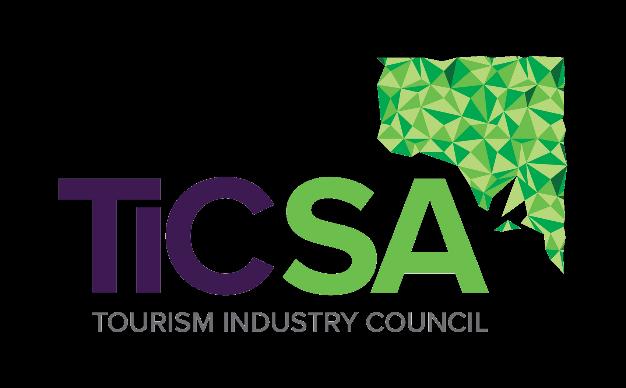TiCSA Tourism Barometer

March quarter 2025



A timefor cautious optimism?
The 2025 March Quarter Tourism Barometer has showed an increase in both business activity and business outlook. The future outlook has improved with almost two-thirds of businesses confident about the next year and future investment intentions are positive. Staffing shortages, which have plagued the industry over the last few years may be softening, however, wages and other business operating costs continue to rise, putting continued pressure on the bottom line of tourism businesses. Of concern is the fact that visitor expenditure has started to decline, arresting the strong growth over the last few years. While this is likely due to decreasing household incomes and the cost of living crisis, the trend is worrying because at the same time visitor yields ($/visitor or night) are also largely falling. The other concern is falling market share to other states, which was on the rise during and directly after the pandemic. All-in-all however, this was a promising set of results and suggests it may be time for some cautious optimism.
Business Activity (Last Three Months)
The main reasons for the positive performance in the March quarter were:
• Introduced new product or service;
• Increased digital presence;
• Favourable weather;

“Increasedinternationalin-market activityandbookingdemand.”
• Increased investment in advertising and promotion; and
• Increased collaboration with other businesses.
The main reasons for the negative performance in the March quarter were:
• Decreased visitors to the area;
• Weaker economy;
• Rising business costs;
• Lack of consumer confidence; and
“Costoflivingpressuresarehaving animpact.”
• Decreased rates, prices or visitor spend in the business.
Figure 3: Business Activity in the Last Three Months
ended
Weaker Stronger Barometer
Source: Tourism Industry Council South Australia
Business Activity by Market Segment (Last Three Months)
Consistent with the headline index, all market segments recorded a small net increase in activity from the December quarter, however, tourism businesses largely recorded no change across all segments.
The “holiday / leisure” and “festivals and events” segments reported the strongest conditions in the quarter, consistent with comments from some respondents that the broader economy appeared to be improving following a difficult period
Conditions were again weakest in the business segments, with just 11% of operators reporting an increase in the “business” segment, while only 8% of the “Conferences and business meetings” segment recorded an improvement in activity.
4: Business Activity – By Market Segment (March quarter 2025)

Source: Tourism Industry Council South Australia
Business Outlook (Next Three Months)
As previously mentioned, the Business Outlook Index rose above the neutral level in the March quarter. Despite the Outlook index having still been negative for five of the last eight quarters, the Index has trended higher since the recent trough in June quarter 2023. This trend, and the index now being above the neutral level, suggests a growing sense of optimism in the tourism industry.
Figure 5: Business Outlook for the Next Three Months
Source: Tourism Industry Council South Australia
Business Outlook (Next 12 Months)
Results in the March quarter were significantly stronger than the previous December quarter. The proportion of businesses ‘extremely worried’ or ‘worried’ fell to 19% in the March quarter, down from 32% in the December quarter.
Additionally, almost two-thirds of businesses (63%) remain ‘extremely confident’ or ‘confident’ in the outlook for their business over the next year, up from 53% in the prior quarter. While this is a strong result, it appears that it is mainly cautious optimism, with just 6% of businesses “extremely confident”. Further, it is important to note that this improved level of confidence is still below the long-term, pre-COVID average of 67%.

Source: Tourism Industry Council South Australia Table 1: The
• Increased visitor numbers and forward bookings;
• Improved product and marketing;
• Improving economy;
• Increased international tourists; and
• Rising confidence.
Source: Tourism Industry Council South Australia
• High cost of living;
• Election uncertainty;
• Low discretionary spend amongst consumers;
• High and rising operating costs; and
• Lack of staff.
Employment and Wages
While the vast majority of tourism businesses continue to report no change in their employment, there continued to be a notable decline in those that are reducing their staff levels in the March quarter.
While staffing levels for most tourism businesses remain unchanged, the wages bill continues to rise with 52% of businesses citing an increase.
Figure 7: Employment Trends

Tourism Industry Council South Australia
Source: Tourism Industry Council South Australia
Data from the ABS Labour Force Survey showed total employment in the accommodation and food services industry rose 1,500 persons to 59,100 in February quarter 2025
While industry employment remains 6,100 persons (or 9%) below the peak in November quarter 2022, over the past year employment has risen 3,400 persons (or 6%). This suggests labour shortage issues that have hampered the tourism industry in recent years may be gradually easing.
Figure 9: SA Employment, Accommodation and Food Services Industry

Source: ABS Labour Force, Australia, Cat. No. 6291.055.003
Key Challenges for Tourism Businesses in SA
Similar to recent Barometers, survey respondents continue to cite rising business and staff costs, lack of cash flow, maintaining staff and, insurance costs as key headwinds facing the industry.
Figure
10:
Key Challenges Facing Tourism Businesses
Source: Tourism Industry Council South Australia
Investment Outlook
Reflecting the overall cautious optimism amongst operators regarding the business outlook, there was a sharp rebound in investment intentions in the March quarter. The proportion of businesses stating they were planning more investment over the next 12 months rose from 29% in the December quarter to 48% this quarter, the strongest result since June quarter 2022. This saw the Index level rise sharply to 130, broadly in line with the pre-COVID average of around 129.
Figure 11: Planned Investment

Quarter ended Less No change More
Source: Tourism Industry Council South Australia
Statistical Note:
The TiCSA Tourism Barometer March quarter 2025 survey was conducted online April 2 – 10. A total of 141 responses were received, representing a margin of error of +/- 8.2% at a confidence level of 95%.
Airport Passengers
Airport passenger numbers through the Adelaide airport have grown marginally (1%) in the March quarter, largely due to a 10% increase in international passengers.
Table 2: Adelaide Airport Quarterly Passenger Statistics
Passengers ('000)
Note: Domestic movements include regional. Source: Adelaide Airport (2025)
Visitation and Expenditure
The strong rebound in visitor expenditure in South Australia appears to have stalled, with visitor expenditure falling $373 million (or 4%) to $9.8 billion in the year ending December 2024 from the prior year. The decline was primarily driven by a large fall in day-trip expenditure (down $440 million, or 20%), while intrastate overnight visitors also fell (down $353 million, or 11%). Meanwhile, international visitor expenditure grew marginally (rising $34 million, or 3%). Possibly pointing to some improvement in the national economy, interstate overnight expenditure rose sharply, up $386 million (or 12%). Across the board, total visitor expenditure in South Australia (down 4% in the year) underperformed against the rest of the nation (up 2%).
With many survey respondents suggesting the national economy may have hit a turning point, it will be interesting to see if domestic expenditure begins to move higher in the coming quarters.

Note: Year ending December.
Source: Tourism Research Australia.
Note: Year ending December. % change is from previous year.
Source: Tourism Research Australia
The latest visitor data for the year ending December 2024 shows total visitation fell 7% in the year to December 2024, with the decline primarily driven by a 12% fall in day-trip visitation
Visitor nights were also down, falling 1% from the prior year, with declines in both intrastate and international visitor nights. Pleasingly, there were sharp increases in both interstate visitors (up 14%) and visitor nights (up 8%) in the year.
While visitor expenditure has stalled at an elevated level, total visitation remains well below pre-COVID levels (-17%) The fall in visitation compared to the pre-COVID level has been driven by significantly lower day-trip visitor numbers, down 24% (or 4.1 million visitors) over this period.
Many of the declines could demonstrate the impact of the cost of living crisis and a decrease in household disposable income, which is a key driver for the tourism industry.

Note: Year ending
Source: Tourism Research Australia
Expenditure fell sharply across the day-trip and intrastate overnight visitor types in the year ending December 2024, driven by both falling visitor numbers and yield ($/visitor) In fact, visitor yields fell across all domestic visitor types but was up 6% amongst international visitors. During the post-COVID era, there had been generally strong growth in expenditure and yields, resulting in considerable growth in visitor expenditure in South Australia and tourism’s contribution to the State’s economy.
However, as demonstrated through the Barometer, the escalations were largely due to tourism businesses increasing prices to address a range of rising business costs.
Of concern is the underperformance of visitor expenditure in South Australia compared to the rest of the country. Total expenditure in South Australia fell 4% in 2024 from 2023, compared to growth of 2% across the rest of the country over the same period.
By visitor type, South Australia recorded a much sharper decline in day-trip expenditure (down 20%) than the rest of the country (down 6%). Intrastate overnight visitor expenditure also fell sharply in South Australia (down 11%), while growing across the rest of the country (up 1%). International expenditure rose just 3% in South Australia in 2024, below the very strong growth of 18% across the rest of the country.
More concerning is the continued drop in South Australia’s market share in both visitors and expenditure, relative to the rest of the country. Only the interstate market demonstrated growth in market share.
Table 5: Expenditure and Yield, South Australia, by Type (2024)

Note: NA – not applicable. Year ending December Market share represents the historical market share currently, for the previous year and from three/ten years ago Source: Tourism Research Australia
Report prepared in partnership with Lucid Economics.
Tourism Industry Council South Australia (TiCSA)
Ph: (08) 8110 0123
Email: info@ticsa.com.au


